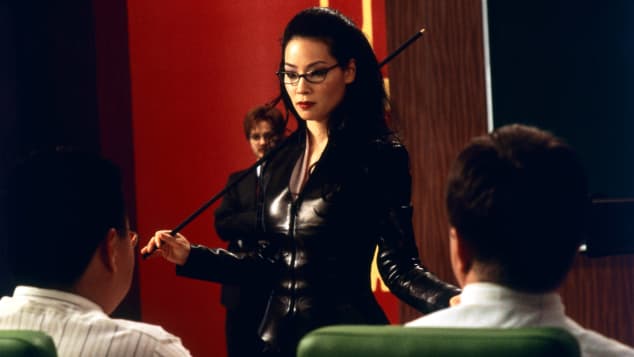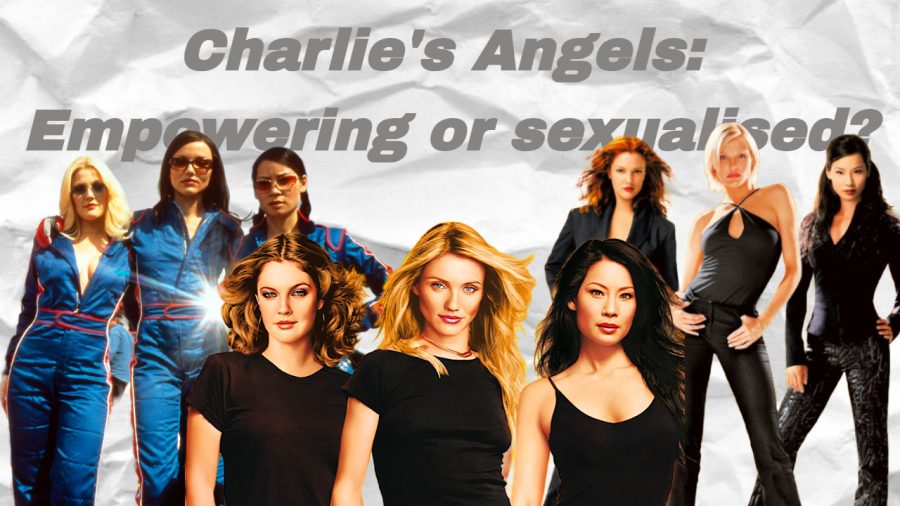Recently, I have rewatched Charlie’s Angels (2000) in hopes of experiencing some nostalgia, as I have a distinct memory of absolutely loving that movie when I was younger. All I remembered was three spies going on missions to save the world; what I did not remember is those said spies being dressed in rather revealing and, dare I say, not suitable for fighting clothes. For me, that was the epitome of the male gaze.
The Male Gaze is a theory introduced by Laura Mulvey, which highlights the objectification and sexualization of women to suit a heterosexual male view. In her essay “Visual Pleasure and Narrative Cinema”, she mainly focuses on women who were presented as side characters; however, her idea that women’s display functions as an erotic object for both characters within the story and spectators within the auditorium (Mulvey) can be applied to Charlie’s Angels as well.
While Charlie’s Angels are the main protagonists of the movie, they are still subject to men’s desires within the film. The most prominent example would be when Alex Munday (Lucy Liu) goes undercover to distract men. Her outfit of choice is as revealing as it “gives off a dangerous air, thereby giving Munday’s sexuality a threatening edge” (Qiao, 2016). In this case, both men in the story , who immediately swap after her like a pack of wolves, and the viewers perceive Liu’s character as an erotic object of their desires. This scenario mainly plays into the “Dragon Lady” trope, which can be “easily prone to be fetishized through the white male’s gaze.” (Wangtechawat, 2021). The Dragon Lady represents the image of the ‘strong’ Asian woman to counteract the typically demure image. (Wangtechawat, 2021). Throughout the film, it is a recurring theme: all three women use their bodies to get what they want from men at some point.

Even though Drew Berrymore participated actively in the film’s production and significantly influenced the process, it is still a movie made chiefly by men with a male audience in mind (Spencer, 2019). As McG, the film’s director, states in one of his interviews, “I was living a dreamŌĆ” It’s like I go to the set, I see Cameron Diaz in a Swiss Miss outfit and Drew Barrymore is in a race car outfit that’s very becoming. Lucy Liu is a dominatrix, and Bill Murray has a tuba wrapped around his head.”. What is interesting here is that he highlights the silly nature of Murray while mentioning only the overtly sexualized outfits of the women. It is as if he does not view them as companions, and their primary value to McG is their appearance. Moreover, while this statement can be explained by the times and as an attempt to promote the film to the male audience, it still represents the male gaze within the film industry.
Taking into account that all three actresses numerously stated how much fun they had while filming the movie and also how they viewed it as empowering rather than oversexualized, it raises a question: can women own their sexuality and their bodies while not surrendering to the male gaze?
Reference List:
CharlieŌĆÖs Angels (2000). Columbia Pictures, Sony Pictures Releasing.
Kleinman, G. (no date) ŌĆśMcG – Director of CharlieŌĆÖs AngelsŌĆÖ, DVD Talk.
Mulvey, L. (1975). Visual Pleasure and Narrative Cinema. Screen, 16, 6-18.
Qiao, S. (2016) ŌĆśFire Breathing ŌĆ£Dragon LadiesŌĆØ: Representations of Asian American Women in MediaŌĆÖ.
Spencer, A. (2019) ŌĆśThe Complicated Legacy of the 2000 CharlieŌĆÖs AngelsŌĆÖ, Vanity Fair. Available at: https://www.vanityfair.com/hollywood/2019/11/the-complicated-legacy-of-the-2000-charlies-angels (Accessed: 2023).
Wangtechawat, P. (2021) ŌĆśPart 4: The Dragon Lady, The Warrior Woman and Asian FemininityŌĆÖ, Pim Wangtechawat. Available at: https://pimwangtechawat.net/2021/06/14/part-4-the-dragon-lady-the-warrior-woman-and-asian-femininity/ (Accessed: 2023).

